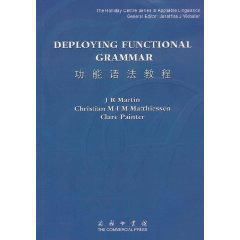內容簡介
《功能語法教程》旨在講授及實踐國際知名語言學家韓禮德所設計的多種語法分析方法,是一部適用於教學和套用方面的工具書。《功能語法教程》與韓禮德所著的《功能語法入門》(IntroductiontoFunctiona1Grammar)第二版和第三版相互參照。《功能語法教程》總結介紹了韓禮德關於小句複合體、分句、語義組和短句語法的主要觀點,闡明了普遍被視為艱深的課題,並附有一系列分級練習,供學生演練學習語法分析技巧用。此外,《功能語法教程》另有一章將上述語法分析同韓禮德富有創意的話語分析、語域及文體方面的研究工作相結合。任何對功能語言學篇章分析有興趣的人士以及希望把韓禮德對語法的真知灼見加以實踐的人士,都會發現《功能語法教程》是一本理想讀物。《功能語法教程》可單獨用作教科書講授功能語法的課程,亦可配合韓禮德所著的《功能語法入門》(IntroductiontoFunctionalGrammar)或其他相關入門書籍使用。閱讀《功能語法教程》無需先熟悉功能語法方面的知識,其讀者對象不僅是初學者,也包括對語言學專門知識及對韓禮德的著作熟悉程度各異的其他讀者。
作者簡介
編者:(澳大利亞)詹姆斯·R·馬丁(JRMartin)(瑞典)克里斯琴·MIM·馬西森(ChristianMIMMatthiessen)(澳大利亞)克萊爾·佩因特(ClarePainter)目錄
PrefaceiChapter1Introduction1
1.Whatisfunctionalgrammar?1
2.Whythisfunctionalgrammar?2
3.Usingtheworkbook3
4.Gettingstartedwithtextanalysis5
5.constituency:functionalandclassunits7
6.Reasoninginafunctionalgrammar10
7.Paradigmsassystemnetworks13
8.Choiceandconstituency16
9.LearningtouseIFG19
Chapter2Theme——clauseasmessage21
1.Orientation21
1.1ReadingguidetoIFG21
1.2CharacterisationofTheme21
1.3Thematicdevebpmentwithinatext22
2.Surveyofoptions22
2.1Ideational(topical}Theme24
2.2InterpersonalTheme25
2.3TextualTheme25
2.4SummaryoftypesofTheme26
2.5Extendingthethematicprinciplebeyondtheclause27
3.Troubleshooting28
3.1Pickingouttheunitofanalysis28
3.2IdentifyingtheTheme28
3.3Identifyingthemetafunction29
3.4SubjectitasunmarkedtopicalTheme32
3.5There'sa...:'existential'clauses35
3.6RecognisinglongerThemeunits35
3.7'Hypotactic'clauseasTheme37
4.Analysispractice38
4.1PhaseI38
4.2PhaseII40
4.3PhaseIII47
5.Reviewandcontextualisation52
5.1DefiningTheme52
5.2ThelocationofTHEMEwithinthegrammaticalresourcesofEnglish52
5.3ThemeandMetafunction53
5.4ThemeandMood54
Furtherreading54
Chapter3Mood——clauseasexchange56
1.Orientation56
1.1ReadingguidetoIFG56
1.2CharacterisationofMood56
2.Surveyofoptions59
2.1BasicMOODtypes60
2.2Overallinterpersonalorganisationoftheclause60
2.3Interpersonalgrammaticalmetaphor67
3.Troubleshooting69
3.1Theunitofanalysis69
3.2Identifyingstructuralelements70
3.3Ambiguousmoodtype75
3.4Ambiguouspolarity76
4.Analysispractice77
4.1PhaseI77
4.2PhaseII82
4.3PhaseIII89
5.Reviewandcontextualisation93
5.1LocatingMOOD93
5.2Interpersonalstructure95
5.3Interpersonalstructureandtextualstructure95
Furtherreading96
Chapter4Transitivity——clauseasrepresentation98
1.Orientation98
1.1ReadingguidetoIFG98
1.2CharacterisationofTRANSITIVITY98
2.SurveyofoptionsI00
2.1Materialclauses102
2.2Mentalclauses103
2.3Relationalclauses104
2.4Verbalclauses106
2.5Behaviouralclauses:betweenmaterialandmental/verbal107
2.6Existentialclauses108
2.7AdditionalAgents108
2.8Ergativeinterpretation109
3.Troubleshooting112
3.1Atopologyofprocesses112
3.2GeneralprobeshelpfulinanalysingforTRANSITIVITY113
3.3Oneprocessortwo?ii4
3.4Materialclauses115
3.5Mentalclauses118
3.6Relationalclauses120
3.7Verbalclauses124
3.8BehaviouralclausesI25
3.9Discriminatingcircumstancetype126
3.10Distinguishingbetweencircumstancesandotherelements126
4.Analysispractice130
4.1PhaseI130
4.2PhaseII137
4.3PhaseIIl146
5.Reviewandcontextualisation153
5.1Theclauseasexperientialconstruct153
5.2Ergativeperspective155
5.3Relationtoothermetafunctions155
Furtherreading159
Chapter5Groupandphrase——belowtheclause161
1.Orientation161
1.1ReadingguidetoIFG161
1.2Characterisationofgroups/phrases161
2.Surveyofoptions165
2.1Nominalgroup165
2.2Verbalgroup171
2.3Othergroups182
2.4prepositionalphrase183
3.Troubleshooting185
3.1Identifyinggroups/phrases185
3.2Assigningafunctiontoawordinagroup186
3.3Differentmeaningsforprepositions196
3.4Assigningafunctiontoaphraseoraclause:rankingorembedded?198
4.Analysispractice200
4.1Nominalgroup201
4.2Verbalgroup212
4.3Adverbialgroup&Prepositionalphrase224
5.Reviewandcontextualisation224
5.1Locatinggroups&phrases:rankandmetafunction224
5.2Nominalgroup225
5.3Verbalgroup226
5.4Prepositionalphrase226
Furtherreading227
Chapter6Theclausecomplex——abovetheclause229
1.Orientation229
1.1ReadingguidetoIFG229
1.2Characterisationofclausecomplex229
2.Surveyofoptions231
2.1TAXlS231
2.2Logico-semantictype234
2.3Summaryofclausecomplexrelations237
3.'Troubleshooting238
3.1Procedureforanalysis238
3.2Pickingouttheunitofanalysis238
3.3Complexingvs.embedding242
3.4Parataxisorhypotaxis?247
3.5Identifyingthelogico-semanticrelation248
3.6Howmany'layers'totheclausecomplex?250
3.7Implicitclausecomplexrelations251
3.8Projection251
3.9'Surfacing'fromanembedding252
4.Analysispractice253
4.1PhaseI253
4.2PhaseII259
4.3PhaselII265
5.Reviewandcontextualisation268
5.1Review268
5.2Relationsbetweenclauses270
Furtherreading271
Chapter7Textanalysis272
1.Orientation272
1.1ReadingguidetoIFG272
1.2Characterisationoftextanalysis272
2.Grammarandbeyond274
2.1Themeandinformationflow276
2.2Clausecomplexingandconjunction278
2.3Transitivityandideation283
2.4Nominalgroups,ideationandidentification284
2.5periodicityandappraisal288
2.6Deixisandmultimodality291
3.Textanalysiscartography293
References299
Index303
 功能語法教程
功能語法教程